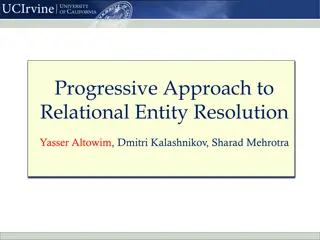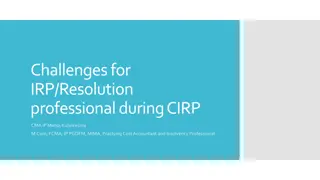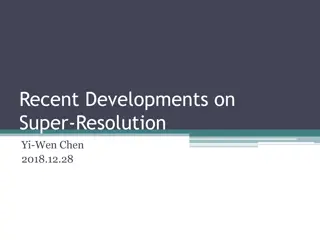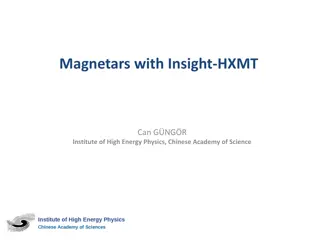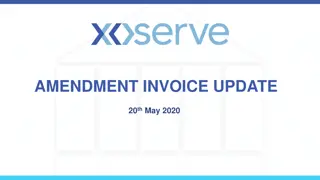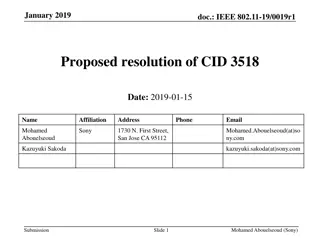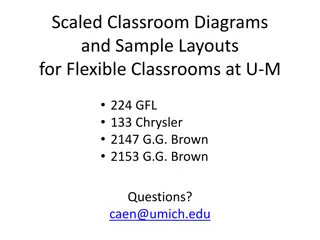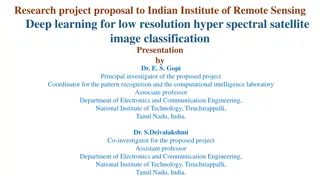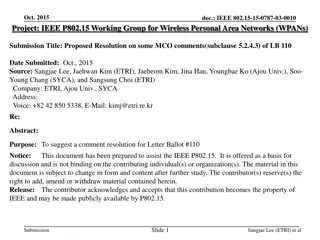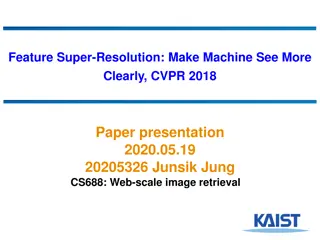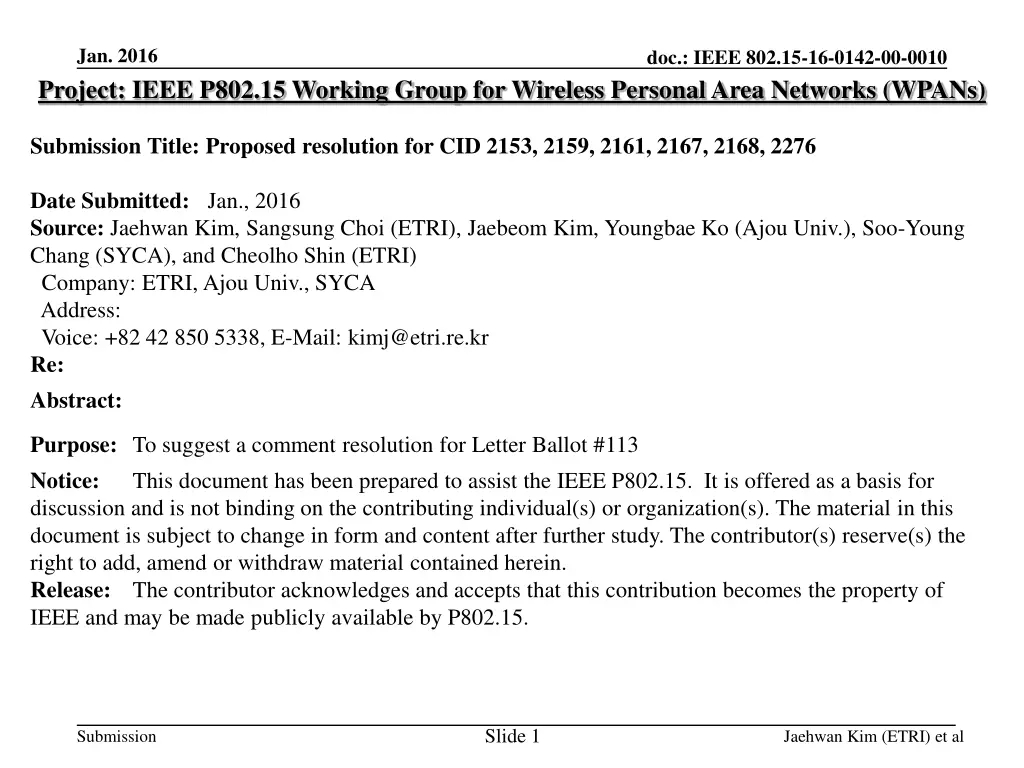
Wireless Personal Area Networks Resolution Proposal
"Explore a proposed resolution for various comments in the IEEE P802.15 Working Group related to routing metrics and path information. The submission addresses concerns and suggests changes to enhance the efficiency of L2R P2P route establishment, focusing on hop count and information exchange between intermediate hops. Key revisions and proposed changes aim to improve the accuracy and effectiveness of network communication protocols." (Word count: 45)
Download Presentation

Please find below an Image/Link to download the presentation.
The content on the website is provided AS IS for your information and personal use only. It may not be sold, licensed, or shared on other websites without obtaining consent from the author. If you encounter any issues during the download, it is possible that the publisher has removed the file from their server.
You are allowed to download the files provided on this website for personal or commercial use, subject to the condition that they are used lawfully. All files are the property of their respective owners.
The content on the website is provided AS IS for your information and personal use only. It may not be sold, licensed, or shared on other websites without obtaining consent from the author.
E N D
Presentation Transcript
Jan. 2016 Project: IEEE P802.15 Working Group for Wireless Personal Area Networks (WPANs) doc.: IEEE 802.15-16-0142-00-0010 Submission Title:Proposed resolution for CID 2153, 2159, 2161, 2167, 2168, 2276 Date Submitted: Jan., 2016 Source: Jaehwan Kim, Sangsung Choi (ETRI), Jaebeom Kim, Youngbae Ko (Ajou Univ.), Soo-Young Chang (SYCA), and Cheolho Shin (ETRI) Company: ETRI, Ajou Univ., SYCA Address: Voice: +82 42 850 5338, E-Mail: kimj@etri.re.kr Re: Abstract: Purpose: To suggest a comment resolution for Letter Ballot #113 Notice: This document has been prepared to assist the IEEE P802.15. It is offered as a basis for discussion and is not binding on the contributing individual(s) or organization(s). The material in this document is subject to change in form and content after further study. The contributor(s) reserve(s) the right to add, amend or withdraw material contained herein. Release: The contributor acknowledges and accepts that this contribution becomes the property of IEEE and may be made publicly available by P802.15. Slide 1 Submission Jaehwan Kim (ETRI) et al
Jan. 2016 doc.: IEEE 802.15-16-0142-00-0010 CID 2153 Commentor Jussi Haapola Related clause 5.2.7 P 37 line 22-24 Comment Why is the hop count the only applicable routing metric in L2R P2P route establishment? Proposed Change If using only hop count as a metric is intentional, it would be convenient to state a reason for such limitation. Slide 2 Submission Jaehwan Kim (ETRI) et al
Jan. 2016 doc.: IEEE 802.15-16-0142-00-0010 CID 2153 Proposed Resolution Revise Relplace "threin" with "retrieved from the hop count field" Slide 3 Submission Jaehwan Kim (ETRI) et al
Jan. 2016 doc.: IEEE 802.15-16-0142-00-0010 CID 2159 Commentor Verotiana Rabarijaona Related clause 5.2.7 P 37 line20 Comment "it does not propagate the P2P-RQ IE but replies with a P2P-RP IE." is not really accurate In storing mode, an intermediate hop only knows the next hop to the destination but not the entire path. Besides, the Hop Count is not recorded. In non-storing mode, only the destination knows the entire path. Unless there is an option to record the paths in intermediate nodes. In each case what kind of information should the Intermediate hop include in the P2P-RP IE? Proposed Change Double check and revise the behavior of the intermediate hops for each mode Slide 4 Submission Jaehwan Kim (ETRI) et al
Jan. 2016 doc.: IEEE 802.15-16-0142-00-0010 CID 2159 Proposed Resolution Revise Replace path with the reachable destination information Add a description of the hop count incensement state. If the Request Direct Response field in the P2P-RQ IE is set to 1 and if an intermediate device has the reachable destination information to the requested destination, it does not propagate the P2P-RQ IE but replies with a P2P-RP IE. The original source device may start routing data frames as soon as it receives a P2P-RP IE. Hop count in the P2P-RP is increase by each forwarding node. When a device receives a new P2P-RP IE, it the therein is lower than the hop count provided by the current next hop, the route record is replaced with the information of the new P2P-RP IE. Otherwise the P2P-RP IE is discarded. Slide 5 Submission Jaehwan Kim (ETRI) et al
Jan. 2016 doc.: IEEE 802.15-16-0142-00-0010 CID 2161 Commentor Verotiana Rabarijaona Related clause 5.2.7 P 37 line 22 Comment "the hop count therein" here is not "Hop Count field in the P2P-RP IE" Proposed Change Add a Hop Count field or revise this description Slide 6 Submission Jaehwan Kim (ETRI) et al
Jan. 2016 doc.: IEEE 802.15-16-0142-00-0010 CID 2161 Proposed Resolution Revise add the hop count and TTL field. remove mesh root address field. Figure 46 Format of the P2P-RP IE Hop Count field The Hop Count field indicates the number of hops between the device currently transmitting the P2P-RQ IE and the original source and is encoded as an unsigned integer. TTL The TTL field indicates the remaining number of times the current P2P-RP IE is allowed to be forwarded and is encoded as an unsigned integer. The initial value of this field is set to hop count in the received P2P-RQ IE Slide 7 Submission Jaehwan Kim (ETRI) et al
Jan. 2016 doc.: IEEE 802.15-16-0142-00-0010 CID 2167 Commentor Jussi Haapola Related clause 5.2.7 P 38 Figure 19 Comment The figure is grossly inaccurate to depict route establishment behavior described in the text of section 5.2.7. The RQ propagation only shows one of the paths leading to the same hop count and does not really show any of the other possibilities. As a whole it causes more conflict with the text than illustrates the behavior. Proposed Change Remove Figure 19. Slide 8 Submission Jaehwan Kim (ETRI) et al
Jan. 2016 doc.: IEEE 802.15-16-0142-00-0010 CID 2167 Proposed Resolution Revise Add a statement for figure 19. Figure 19 shows an example of the P2P route establishment between devices D and H. In this figure, the arrows for P2P-RQ message are represented only source device H to reduce the complexity. If G has a path to H and if intermediate response is enabled, G responds with a P2P-RP IE without reforwarding an in incoming P2P-RQ IE. Otherwise, all devices forward the P2P-RQ IE. Slide 9 Submission Jaehwan Kim (ETRI) et al
Jan. 2016 doc.: IEEE 802.15-16-0142-00-0010 CID 2168 Commentor Verotiana Rabarijaona Related clause 5.2.7 P 38 line 11 Comment What is the meaning of the non-bold arrow from H to G? Proposed Change Add a legend or make it bold. Slide 10 Submission Jaehwan Kim (ETRI) et al
Jan. 2016 doc.: IEEE 802.15-16-0142-00-0010 CID 2168 Proposed Resolution Revise make the bold arrow from H to G bold. R P2P-RQ IE P2P-RP IE A B C source device Destination D E F G H I J K L M N O Direct response is enabled Direct response is disabled Slide 11 Submission Jaehwan Kim (ETRI) et al
Jan. 2016 doc.: IEEE 802.15-16-0142-00-0010 CID 2276 Commentor Verotiana Rabarijaona Related clause 6.1.5.1 P 66 line 19 Comment There is no Mesh Root Address in Fig. 44. Proposed Change Add the field or delete subclause 6.1.5.1. Slide 12 Submission Jaehwan Kim (ETRI) et al
Jan. 2016 doc.: IEEE 802.15-16-0142-00-0010 CID 2276 Proposed Resolution Revise Delete Mesh Root Address field Slide 13 Submission Jaehwan Kim (ETRI) et al

